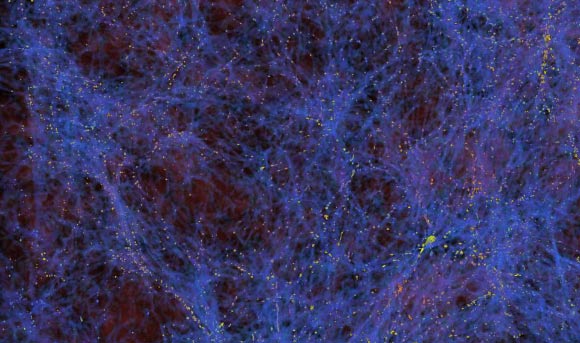Dark matter is the mysterious substance that makes up roughly a quarter of the Universe. There is strong indirect evidence for its existence from measurements of cosmic primordial radiation, anomalies in the radial dependence of galactic rotational curves and gravitational lensing. Despite its apparently pivotal role in the Universe the physical origin of dark matter remains unknown. Scientists suspect that it is made of unseen particles that neither reflect nor absorb light, but are able to exert gravity. Two theoretical physicists at the University of York, UK, have a new candidate: a recently-discovered bosonic particle, the d*(2380) hexaquark.
Source: Sci News
The d*(2380) hexaquark is composed of six quarks, the fundamental particles that usually combine in trios to make up protons and neutrons.
Importantly, the six quarks in a d*(2380) result in a boson particle, which means that when many d*(2380) are present they can combine together in very different ways to the protons and neutrons.
University of York’s Dr. MIkhail Bashkanov and Professor Daniel Watts suggest that in the conditions shortly after the Big Bang, many d*(2380) hexaquarks could have grouped together as the Universe cooled and expanded to form the fifth state of matter — Bose-Einstein condensate.
“The origin of dark matter in the Universe is one of the biggest questions in science and one that, until now, has drawn a blank,” Professor Watts said.
“Our first calculations indicate that condensates of d*(2380) hexaquarks are a feasible new candidate for dark matter.”
“This new result is particularly exciting since it doesn’t require any concepts that are new to physics.”
“The next step to establish this new dark matter candidate will be to obtain a better understanding of how the d*(2380) hexaquarks interact — when do they attract and when do they repel each other,” Dr. Bashkanov said.
“We are leading new measurements to create d*(2380) hexaquarks inside an atomic nucleus and see if their properties are different to when they are in free space.”
The team’s paper was published in the Journal of Physics G: Nuclear and Particle Physics.
Source: Sci News

































Leave a Comment
You must be logged in to post a comment.